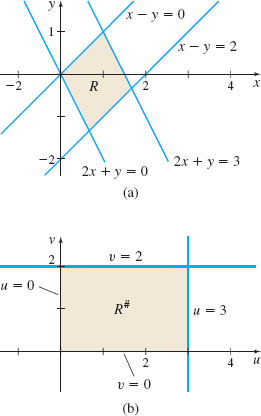EXAMPLE 2Using a Jacobian in a Double Integral
Find ∬, where R is the region enclosed by the lines 2x+y=0, \ \ 2x+y=3, x-y=0, and x-y=2.
Solution We use the change of variables u=2x+y and v=x-y. Then the lines 2x+y=0 and 2x+y=3 in the xy-plane correspond to the lines u=0 and u=3 in the uv-plane. The lines x-y=0 and x-y=2 in the xy-plane correspond to the lines v=0 and v=2 in the uv-plane. As Figure 63 shows, the region R in the xy-plane is a parallelogram and the region R^{\#} in the uv-plane is a rectangle.
To find the Jacobian, we need to express x and y as functions of u and v. We can achieve this by solving the system of equations \left\{ \begin{array}{l} u=2x+y \\ v=x-y \end{array} \right. for x and y. Then x=\dfrac{u+v}{3} \qquad y=\dfrac{u-2v}{3}
The Jacobian is \begin{equation*} \dfrac{\partial (x,y)}{\partial (u,v)}=\left\vert \begin{array}{c@{\quad}c} \dfrac{\partial x}{\partial u} & \dfrac{\partial x}{\partial v}\\[3pt] \dfrac{\partial y}{\partial u} & \dfrac{\partial y}{\partial v} \end{array} \right\vert =\left\vert \begin{array}{l@{\quad}r} \dfrac{1}{3} & \dfrac{1}{3}\\[3pt] \dfrac{1}{3} & -\dfrac{2}{3} \end{array} \right\vert =-\dfrac{2}{9}-\dfrac{1}{9}=-\dfrac{1}{3} \end{equation*}
Using this change of variables, the integral \iint\limits_{\kern-2ptR}y\,d\!A becomes \begin{eqnarray*} \iint\limits_{\kern-3ptR}y\,d\!A &=&\displaystyle\iint\limits_{\kern-3ptR^{\#}}\dfrac{u-2v}{3}\cdot \left\vert -\dfrac{1}{3}\right\vert \,du\,dv=\int_{0}^{2}\int_{0}^{3}\dfrac{1}{9}(u-2v)\,du\,dv=\dfrac{1}{9}\int_{0}^{2}\left[ \dfrac{u^{2}}{2}-2uv\right]_{0}^{3}\,dv\\ &=&\dfrac{1}{9}\int_{0}^{2}\left( \dfrac{9}{2}-6v\right) {dv}=\dfrac{1}{9}\left[\dfrac{9v}{2}-3v^{2}\right] _{0}^{2}=\dfrac{1}{9}(9-12)=-\dfrac{1}{3} \end{eqnarray*}
